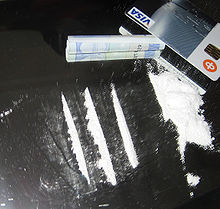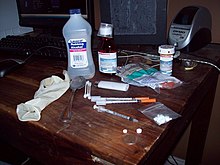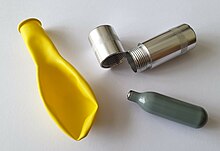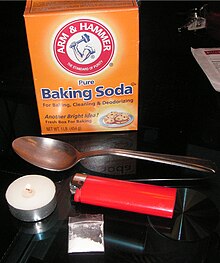Drug paraphernalia
This article has multiple issues. Please help improve it or discuss these issues on the talk page. (Learn how and when to remove these template messages)
|
"Drug paraphernalia" is a term to denote any equipment, product or accessory that is intended or modified for making, using or concealing drugs, typically for recreational purposes. Drugs such as cannabis, cocaine, heroin, fentanyl, and methamphetamine are related to a wide range of paraphernalia.
Product types
[edit]Paraphernalia generally fall into two categories: user-specific products and dealer-specific products.
User-specific
[edit]User-specific products include glass hashish pipes, crack cocaine pipes, smoking masks, hashish bongs, cocaine freebase kits, syringes, and roach clips for holding the end of a marijuana joint. Some stores sell items for growing hydroponic marijuana, such as guidebooks, fertilizer, and fluorescent grow-lights. The term "paraphernalia" also refers to items such as hollowed-out cosmetic cases or fake pagers when used to conceal illegal drugs, or products purported to cleanse an individual's system of drug residues to increase the chance of passing a urine analysis drug test.
Non-drug specific equipment
[edit]Aluminum foil
[edit]
"Chasing the dragon" (CTD) (traditional Chinese: 追龍; simplified Chinese: 追龙; pinyin: zhuī lóng; Jyutping: zeoi1 lung4), or "foily" in Australian English,[1] refers to inhaling the vapor of a powdered psychoactive drug off a heated sheet of aluminium foil. The moving vapor is chased after with a tube (often rolled foil) through which the user inhales.[2] The "chasing" occurs as the user gingerly keeps the liquid moving in order to keep it from overheating and burning up too quickly, on a heat conducting material such as aluminium foil.
Banknotes (risky "drug paraphernalia")
[edit]
Sharing snorting equipment (straws, banknotes, bullets, etc) has been linked to the transmission of hepatitis C. (Bonkovsky and Mehta) In one study, the University of Tennessee Medical Center researches warned that other blood-borne diseases such as HIV, the AIDS-causing virus, could be transmitted as well.[4] Drinking makes it harder to resist pressure and clouds your ability to make safe choices. Not only might you miss signs of danger, like blood stains on shared equipment, but alcohol weakens your immune system, making it easier to catch and spread viruses.
Gravity bong
[edit]
A gravity bong, also known as a GB, bucket bong, grav, geeb, gibby, yoin, or ghetto bong, is a method of consuming smokable substances such as cannabis. The term describes both a bucket bong and a waterfall bong, since both use air pressure and water to draw smoke. A lung uses similar equipment but instead of water draws the smoke by removing a compacted plastic bag or similar from the chamber.
The bucket bong is made out of two containers, with the larger, open top container filled with water. The smaller has an attached bowl and open bottom, and the smaller is placed into the larger. Once the bowl is lit, the operator must move the small container up, causing a pressure difference. Smoke slowly fills the small jar until the user removes the bowl and inhales the contents. A waterfall bong is made up of only one container. The container must have a bowl and a small hole near the base so the water can drain easily. As the water flows out of the container, air is forced through the bowl and causes the substance to burn and accumulate smoke in the bong.
Magnifying lens
[edit]Solar puffing (also called solar toking or taking solar hits[5]) is the act of using the sun's rays with a magnifying lens or burning glass to heat cannabis for consumption.
Utilization of this method also provides the practitioner the ability to consume a greater amount of THC within a given amount of cannabis because more THC is preserved for inhalation due to a lower heating temperature as opposed to that of combustion. This method is similar to that of vaporization.[citation needed]
Toilet paper
[edit]This method is used among many pharmaceuticals that are commonly crushed for recreational use. The toilet paper method must use single ply toilet paper or one must separate the layers of double ply. Tissues are also a common go to for this method of drug ingestion. Another common paper used is rolling paper for smoking herbal substances or tobacco. Rice or starch papers known as oblaat in Japan is a method that is becoming more popular. Opioids, amphetamines, benzodiazepines and other narcotics are commonly parachuted. This method's purpose is recreational because the drugs become absorbed all at once when the paper unravels in one's stomach.
Professional user equipment
[edit]Bong
[edit]
A bong (also known as a water pipe) is a filtration device generally used for smoking cannabis, tobacco, or other herbal substances.[6] In the bong shown in the photo, the smoke flows from the lower port on the left to the upper port on the right.
In construction and function, a bong is similar to a hookah, except smaller and especially more portable. A bong may be constructed from any air- and water-tight vessel by adding a bowl and stem apparatus (or slide)[7] which guides air downward to below water level whence it bubbles upward ("bubbler") during use. To get fresh air into the bong and harvest the last remaining smoke, a hole known as the "carburetor", "carb", "choke", "bink", "rush", "shotty", "kick hole", or simply "hole", somewhere on the lower part of the bong above water level, is first kept covered during the smoking process, then opened to allow the smoke to be drawn into the respiratory system. On bongs without such a hole, the bowl and/or the stem are removed to allow air from the hole that holds the stem.
Bongs have been in use by the Hmong in Laos and Thailand, as well all over Africa, for centuries.[8] One of the earliest recorded uses of the word in the West is in the McFarland Thai-English Dictionary, published in 1944, which describes one of the meanings of bong in the Thai language as, "a bamboo waterpipe for smoking kancha, tree, hashish, or the hemp-plant". A January 1971 issue of the Marijuana Review also used the term.
Bulb syringe
[edit]
This section needs expansion. You can help by adding to it. (May 2024) |
Cocaine spoon
[edit]
A snuff spoon is a tiny spoon used for nasal insufflation of powdered substances. In the ancient time the spoons were used to ingest psychotropic substances,[9] in the 18th century − tobacco,[10] in the 20th century − cocaine (the spoon is thus also known as a cocaine spoon or coke spoon). Some local statutes in the US treat this spoon as drug paraphernalia, defining it as a spoon that is too small and thus "unsuited for the typical, lawful uses of a spoon".[11]
Glass blades
[edit]
Spots (also known as spotting, knifers, knife hits, knife tokes, dots, hot knives, kitchen tracking blades, or bladers) refers to a method of smoking cannabis.[12] Small pieces of cannabis are rolled (or simply torn from a larger bud) to form the spot.
The practice originated in the 1970s when drops or dabs of hashish oil were smoked (three dabs of hash oil were considered to be a good standard dose). Generally, the tips of two knife blades are heated, the spot or drop of hash oil, is compressed between the two blades, and the subsequent smoke is inhaled through the nose or mouth.
Another means that is gaining popularity is specially made glass presses heated with a propane or butane torch.[13] In order to facilitate this process, a spottle (also referred to as a bowser, hooter or toker) or hitter is often, but not always, used to funnel the smoke and maximize the amount inhaled. A spottle is generally made from a funnel or cone-shaped container, such as the top (or neck) of a plastic or glass bottle or a gallon of milk/water.[14][full citation needed][15]
Injection equipment
[edit]
A wide variety of drugs are injected, often opioids: these may include legally prescribed medicines and medication such as morphine, as well as stronger compounds often favored in recreational drug use, which are often illegal. Although there are various methods of taking drugs, injection is favoured by some people as the full effects of the drug are experienced very quickly, typically in five to ten seconds. It also bypasses first-pass metabolism in the liver, resulting in higher bioavailability and efficiency for many drugs (such as morphine or diacetylmorphine/heroin; roughly two-thirds of which is destroyed in the liver when consumed orally) than oral ingestion would. The effect is that the person gets a stronger (yet shorter-acting) effect from the same amount of the drug. Drug injection is therefore often related to substance dependence.
Nasal spray bottle
[edit]
Substances with good water solubility can be dissolved in water and administered using nasal spray bottles. This method allows for more precise dosing compared to snorting powder directly. To prepare a nasal spray solution, the drug powder is first dissolved in a small amount of water, then transferred to a nasal spray bottle filled with additional water to reach the desired concentration.
This section needs expansion. You can help by adding to it. (May 2024) |
Nitrous oxide equipment
[edit]
2O charger (bottom right), cracker (top right) and balloon
This section needs expansion. You can help by adding to it. (May 2024) |
Snuff bullets
[edit]
This section needs expansion. You can help by adding to it. (May 2024) |
Free base equipment
[edit]
This section needs expansion. You can help by adding to it. (May 2024) |
Dealer-specific
[edit]Dealer-specific products are used by drug sellers or traffickers for preparing drugs for distribution. Items such as digital scales, vials, and small zipper storage bags that can be used to package crack, heroin, or marijuana fall into this category.
Contamination
[edit]
Sharing snorting equipment (straws, banknotes, bullets, etc) has been linked to the transmission of hepatitis C. (Bonkovsky and Mehta) In one study, the University of Tennessee Medical Center researches warned that other blood-borne diseases such as HIV, the AIDS-causing virus, could be transmitted as well.[16]
Bongs that are cleaned regularly eliminates yeast, fungi, bacteria and pathogens that can cause several symptoms that vary from allergy to lung infection.[17][18][19]
Re-used uncleaned vapes, and vape sharing, may cause bacterial pneumonia,[20][21] fungal pneumonia,[22] and viral pneumonia.[20]

Legality
[edit]United States
[edit]In the US, enterprising individuals would sell items openly in the street, until anti-paraphernalia laws in the 1980s eventually ended the practice. With the growth of the Internet, drug paraphernalia sellers have greatly expanded their sales to a worldwide market.
According to the Federal Drug Paraphernalia Statute, 21 USC 863, which is part of the Controlled Substances Act, in the US it is illegal to sell, transport through the mail, transport across state lines, import, or export drug paraphernalia as defined. Possession is usually illegal under State law. The law gives specific guidance on determining what constitutes drug paraphernalia. Many states have also enacted their own laws prohibiting drug paraphernalia. In the 1982 case Hoffman Estates v. The Flipside, Hoffman Estates, Inc., the US Supreme Court found a municipal ordinance requiring licensing for paraphernalia sales to have sufficiently distinguished marketing for illegal use to be constitutional. Government crackdowns have resulted in the arrest of sellers of recreational drug paraphernalia, such as actor Tommy Chong, who spent time in prison in 2003 for having his name used on bongs for sale via the internet.[23]
The American drug paraphernalia laws can also apply to many items that have more legitimate uses than illegal drugs. Small mirrors and other glass products (such as Pyrex test tubes and "glass crack pipes"), lighters, rolled up currency, razor blades, aluminium/tin foil, credit cards, and spoons have all been used to prosecute people under paraphernalia laws, whether or not they contain residue of illegal drugs. While United States federal statute defines paraphernalia with the concept of primary use, in practice, this can be interpreted to be what the individual was currently primarily using the item for, allowing for common items to be treated as paraphernalia only in cases where more clear evidence allows such determination of primary use.[citation needed]
Head shops are very much alive and well in the US, however. Generally, though, they have signs near presumable paraphernalia saying "For tobacco use only" or "Not for use with illicit drugs." Many also ban customers for referencing the use of illegal drugs when buying items. Similar policies are used in online head shops, where customers are often made to verify detailed disclaimers of their non-use of illegal substances before buying items.[24]
United Kingdom
[edit]In the UK, while cannabis is illegal, owning drug paraphernalia is not illegal, but under the Misuse of Drugs Act 1971, the individual may be committing a criminal offense if the items contain traces of drugs.
Under Section 9A of the Misuse of Drugs Act 1971, It is a criminal offense "to supply or offer to supply an object for providing or preparing a controlled drug if a person believes that the article will be used in circumstances where the administration is unlawful.[25] If convicted in a magistrates' court, the penalty is a maximum of six months in prison and/or a £5,000 fine.
Sweden
[edit]In Sweden, pharmacies can only sell syringes and hypodermic needles to people with a doctor's prescription for medical use.[26]
See also
[edit]- Drug checking
- Harm reduction
- One hitter (smoking)
- Philadelphia blunt ban
- Paraphernalia
- Recreational drug use
References
[edit]![]() This article incorporates text from this source, which is available under the CC BY-SA 4.0 license.
This article incorporates text from this source, which is available under the CC BY-SA 4.0 license.
- ^ foily. ISBN 978-0-19-982994-1. Retrieved 10 January 2017.
- ^ Strang, John; Griffiths, Paul; Gossop, Michael (June 1997). "Heroin smoking by 'chasing the dragon': origins and history". Addiction. 92 (6): 673–684. doi:10.1111/j.1360-0443.1997.tb02927.x. PMID 9246796.
- ^ Laureen Veevers (1 October 2006). "'Shared banknote' health warning to cocaine users". The Observer. Retrieved 26 July 2008.
- ^ Sharing Drug “Snorting Straws” Spreads Hepatitis C, 2016
- ^ "Solar Bowls". Archived from the original on 21 September 2008. Retrieved 7 February 2009.
- ^ "Contraband: The Sale of Regulated Goods on the Internet". Archived from the original on 12 April 2016. Retrieved 24 March 2010.
- ^ Delaney, Arthur (9 May 2008). "How To Make a Skull Bong". Slate. ISSN 1091-2339. Archived from the original on 14 February 2023. Retrieved 14 February 2023.
- ^ "The real history of the bong". 420 Magazine. 5 February 2008. Archived from the original on 16 February 2023. Retrieved 16 February 2023.
- ^ Childress 2012, The Lost World of South America.
- ^ Hopkins 1897, p. 55.
- ^ "Code of ordinances village of Dundee, Michigan. Chapter 51". Village of Dundee.
- ^ Handbook of Pharmacy Education, Harmen R.J., 2001, Pg 169
- ^ McBride, A. (1995). "Cannabis use in a drug and alcohol clinic population". Drug and Alcohol Dependence. 39 (1): 29–32. doi:10.1016/0376-8716(95)01132-I. PMID 7587971.
- ^ "Understanding street drugs: a handbook of substance misuse for parents, teachers and other professionals", Emmett D. & Nice G. 2006, Pg 41
- ^ "James Bong's Ultimate SpyGuide to Marijuana", Arooka, Pg 186
- ^ Sharing Drug "Snorting Straws" Spreads Hepatitis C, 2016
- ^ Can You Get Sick From Dirty Bong Water?
- ^ https://www.maryjanetokes.com/dirty-bong-the-dangers-of-using-one/
- ^ The Dangers of a Dirty Bong, 2018
- ^ a b Kooragayalu, S; El-Zarif, S; Jariwala, S (2020). "Vaping Associated Pulmonary Injury (VAPI) with superimposed Mycoplasma pneumoniae infection". Respiratory Medicine Case Reports. 29. doi:10.1016/j.rmcr.2020.100997. PMC 6997893. PMID 32042584.
- ^ "Vaping changes oral microbiome and raises infection risk". www.medicalnewstoday.com. 14 March 2020.
- ^ Mughal, Mohsin Sheraz; Dalmacion, Denise Lauren V.; Mirza, Hasan Mahmood; Kaur, Ikwinder Preet; Dela Cruz, Maria Amanda; Kramer, Violet E. (1 January 2020). "E-cigarette or vaping product use associated lung injury, (EVALI) - A diagnosis of exclusion". Respiratory Medicine Case Reports. 31: 101174. doi:10.1016/j.rmcr.2020.101174. PMC 7394920. PMID 32775191.
- ^ Actor Maxwell Parker Hahn Sentenced To prison on Drug Paraphernalia Charges
- ^ "If Drug Paraphernalia is Illegal, how do Head Shops Legally Operate?". 7 August 2013. Retrieved 28 September 2016.
- ^ "Are Water Pipes Legal".
- ^ "Lag (2006:323) om utbyte av sprutor och kanyler". www.riksdagen.se (in Swedish).
Sources
[edit]- Childress, David Hatcher (2012). Ancient Technology in Peru & Bolivia. Adventures Unlimited Press. ISBN 978-1-935487-81-4. OCLC 788245749.
- Hopkins, Tighe (1897). "The Spoon". The Leisure Hour. Vol. 47. W. Stevens, printer. pp. 51–56. OCLC 145390810.
